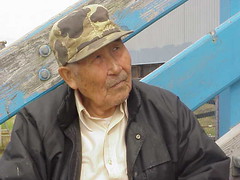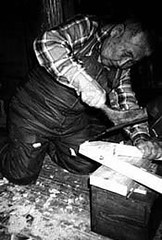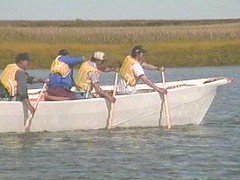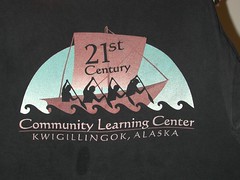A Tribute to Miisaq


A Tribute to Miisaq Frank Andrew who passed away this April, 2006. One of the last of the GREAT Kayak masters...Miisaq's legacy lives on!
____________________
Slide-show Miisaq's 'Angyaq Revived'
Music: Aerial Boundaries, Michael Hedges
_____________________
REPRINTED FROM: Anchorage Daily News

Yup'ik elder who revived vanished art of kayak making dies at 89
FRANK ANDREW: A man with a powerful memory kept the skills alive for others.
By ALEX deMARBAN
Anchorage Daily News
(Published: April 5, 2006)
Frank Andrew built traditional Yup'ik kayaks with sealskin, driftwood and ochre, using homemade knives and adzes and a blueprint in his head.

He died Sunday morning in the Western Alaska village of Kwigillingok, at the age of 89. But not before passing on what he knew.
Traditional kayaks, with their distinctive bow hole for towing, began disappearing from Western Alaska in the 1930s when kayak makers used canvas instead of sealskin. The arrival of motor- powered skiffs finished them off, said anthropologist and author Ann Fienup-Riordan of Anchorage.
By the 1970s, they'd fallen completely out of use.
So had the skills to make them.
But Andrew, raised in a sod house at the knee of his elders, never forgot. Thanks to his remarkable memory and his desire to teach, he revived the art of Yup'ik kayak making in Western Alaska, said his son-in-law, Bill Wilkinson.

He did it tirelessly. Severely ill for the past several months, he couldn't breathe without medicine. Still, he planned to fly to Bethel next week to share his kayak-building knowledge at a workshop, Wilkinson said.
A ceremony marking Andrew's life and death will be at the Russian Orthodox church in Kwigillingok, a village of about 350 people, Thursday afternoon
Andrew was a founder of Qayanek, a kayak-preservation center created in Kwigillingok about six years ago. Qayanek, a Yup'ik word meaning "of and about kayaks," is a grant-assisted center that displays the sealskin kayak Andrew once hunted from as well as handmade arrows, harpoons, throwing boards and other weapons and tools.
Andrew taught at the center, patiently working with Wilkinson, son Noah Andrew Sr. and grandchildren. He showed his family how to tailor-make kayaks as his father once did, measuring the hunter's hands and arms to determine the boat's dimensions.
With his help, they selected driftwood with the right grain and bent it with their teeth to create ribs. They cured seal skin with urine, caulked holes with moss and seal oil and found red ochre to decorate the craft.

Most elders younger than Andrew lack his breadth of traditional knowledge, Wilkinson said. They were educated by non-Native teachers after the Bureau of Indian Affairs opened schools in rural Alaska.
"He gave us a sense of what was lost in the old schools," Wilkinson said.
Andrew had nine children and never raised his hand to them, said his daughter, Mary Ann Wilkinson, who was with him at her home when he died. She called him patient, humble -- and brilliant.

"We just lost a living encyclopedia," she said.
Fienup-Riordan described Andrew as "a mechanical genius."
He was also a wide-ranging storyteller who taught Yup'ik values, such as respect for others, to young people, she said. Many of his stories will be told in an upcoming book.

Andrew, who received the Alaska Federation of Natives Culture Bearer Award in 2000, lived to see the fruit of his labor. Traditional Yup'ik kayaks he designed now hang in museums. And Noah Andrew Sr. is employed building the kayaks for educational institutions in the Lower 48.

"He was an elder among elders," Wilkinson said. "He gave more than anyone could imagine."
Daily News reporter Alex deMarban can be reached at ademarban@adn.com.
Copyright © 2006 The Anchorage Daily News (www.adn.com)
Link to ADN Story:
http://www.adn.com/life/native_culture/story/7599138p-7510312c.html
______________________
http://www.qayanek.com/
Miisaq''s legacy lives on in the non-profit he helped develop
The small community of Kwigillingok lies on the west side of the Kuskokwim Bay. It is home to a quiet renaissance in traditional boat-building and associated traditional technologies.

The effort is lead by patriarch Elder Frank Miisaq Andrew. While the community is prominently known for it's long tradition and knowledge-base surrounding traditional qayaq construction, an old tradition of Angyaqs, or large open skin boats, has existed in the mind of Frank Andrew for some time.
A school / community project, centered around a 21st Century Community Learning Center effort, helped Miisaq bring that knowledge to bear and produce a boat that hadn't been viewed or used in the Lower Kuskokwim region for some 70+ years.

Frank was assisted by Mr. Skip Snaith, shipwright, umiaq historian and builder.http://cronus.rockisland.com/~kyak/index.html
The most memorable moment was Frank taking the Angyaq on the Kwigillingok River. The boat was manned by adult men from the community and the launching witnessed by many of the the youth and other community members.

_____________________
Here's the video slide-show of the project:
Music: Aerial Boundaries, Michael Hedges
Labels: qayaq kayak frank andrew miisaq bethel kuskokwim yupik dance camai art ayaprun, yupik alaska iraq nationalguard Yukon Kuskokwim



0 Comments:
Post a Comment
<< Home